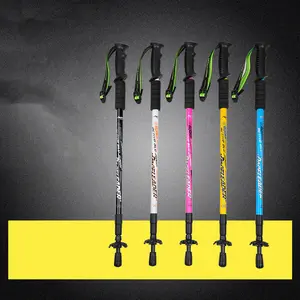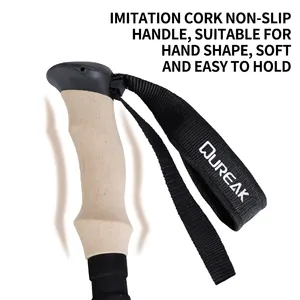
Super Quality Telescopic Trekking Poles Telescopic Camping Outdoor Equipment Walking Stick Walking Cane


Outdoor Custom Logo 3-section Telescopic Trekking Hiking Pole Manufacturers Aluminum 7075 Walking Sticks Trekking Pole





















Ski poles are an essential piece of equipment for skiers, designed to improve balance, provide propulsion, and aid in turning while traversing snowy slopes. They consist of a long shaft with a grip at one end and a basket near the bottom to prevent them from sinking too deep into the snow. The primary users of ski poles are alpine and nordic skiers, who rely on them for different purposes depending on their skiing style. In alpine skiing, poles are mainly used for timing turns and balance, while in nordic skiing, they're crucial for propulsion.
The principle behind ski poles is to provide skiers with additional points of contact with the snow, which helps in various ways. For instance, when pushing off flat terrain or during uphill sections, the poles help skiers gain forward momentum. Furthermore, they assist skiers in maintaining a rhythmic pattern while making turns, where planting the pole at the initiation of a turn can help stabilize and steer the body. Ski poles also come in handy during falls, offering something to grasp onto in order to get back up.
Selecting the right ski poles involves considering several factors such as the type of skiing, the skier's height and skill level, and the pole's material and features. With proper ski poles, skiers can enhance their performance on the slopes while also reducing fatigue and preventing injury.
There is a wide array of ski poles available to cater to different types of skiing activities and preferences. Here are some common types:
Each type has its common use cases, with some being more suited for casual skiing and others designed for specific skiing disciplines or conditions.
When selecting ski poles for your business's inventory or for outfitting your sports organization, consider the intended use case of the poles and the type of clientele you serve. Start by assessing the materials: aluminum is cost-effective and robust, ideal for rental operations or budget-conscious customers; carbon fiber is lightweight and reduces arm fatigue, suitable for advanced skiers; aluminum alloy variations offer different grades of strength; natural materials like bamboo can appeal to those looking for an eco-friendly option.
Next, evaluate features such as weight distribution, durability, grip material (such as rubber or cork), and whether the pole offers adjustability – a feature that adds versatility for varying terrains. Consider also offering ski poles with different basket sizes suitable for various snow conditions—smaller baskets for groomed runs and larger ones for powder snow.
The color options available can help your clients match their gear or brand colors. Additionally, various grip materials provide comfort choices—rubber grips are durable whereas cork can offer a more comfortable feel. When purchasing in bulk for resale or outfitting a team or organization, consider combo sets that may include multiple pairs of poles at different sizes or bundled with other skiing equipment.
Lastly, it's essential to work with reputable suppliers who offer product quality assurance and reliable delivery services—key factors in maintaining your business operations smoothly.
For businesses seeking an extensive selection of ski poles suitable for various markets and needs, Alibaba.com stands out as an exemplary marketplace. With its global reach connecting buyers with suppliers from all around the world, Alibaba.com offers access to a multitude of options catering to every skiing style and preference without compromising on quality or reliability.
With its user-friendly platform that supports local languages and mobile accessibility, Alibaba.com ensures that finding the right ski poles is both convenient and efficient. The site's emphasis on secure transactions through services like Trade Assurance gives businesses peace of mind when ordering products in bulk. Furthermore, Alibaba.com's focus on assisting small to medium-sized enterprises translates into an understanding that every business requires specialized attention to meet its unique demands.
Choosing Alibaba.com as your go-to source for wholesale ski poles means benefiting from not only a wide range of products but also personalized customer service that recognizes the value of fostering strong B2B relationships. Whether you're outfitting a retail store or sourcing for a sports team or resort rental service, Alibaba.com is equipped to facilitate your procurement process with ease and confidence.
When assessing the quality of ski poles, focus on material strength, weight, flexibility, and grip comfort. High-quality poles often feature durable materials such as carbon fiber or high-grade aluminum and have ergonomic grips.
The material of ski poles impacts their weight, stiffness, and vibration absorption. For example, carbon fiber offers lightweight and reduced vibration, ideal for performance skiers, while aluminum provides durability at a lower cost for recreational use.
Adjustable ski poles are versatile and can accommodate different height requirements, making them an excellent choice for ski rental businesses looking to serve a wide range of customers with fewer inventory items.
Ski pole grips are commonly made from rubber, cork, plastic, or foam materials. Rubber grips are durable and offer good hold in various conditions, while cork grips provide comfort and a natural feel.
Yes, many suppliers offer customization options for color and design to align with company branding or team colors. This can be an important factor for businesses in creating a cohesive look for their equipment.
Basket size is crucial as it determines how well the pole will perform in different snow conditions. Larger baskets are better suited for powder snow to prevent sinking, while smaller baskets are adequate for groomed trails.
For competitive skiing, factors like aerodynamics, weight, strength, and vibration damping are crucial. Poles should be streamlined for minimal air resistance and made from materials that combine lightness with high durability.
There is no one-size-fits-all when it comes to ski pole length; it varies based on the user's height and skiing style. Proper sizing ensures optimal performance and comfort.
Offering combo sets can provide customers with value by bundling necessary items together at a discounted rate, and it can simplify purchasing decisions by providing a complete solution in one package.
Different stick tips offer varying degrees of traction and durability. Tungsten or carbon tips are often used for precision and durability on ice or hard-packed snow, whereas rubber tips might be preferred for their shock absorption properties on mixed terrain.
Eco-friendly options can appeal to environmentally conscious consumers and align with sustainability initiatives. They may also differentiate a business's product line in a competitive market.